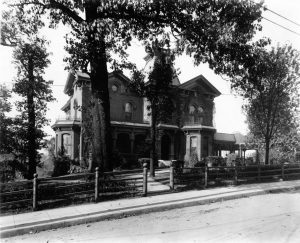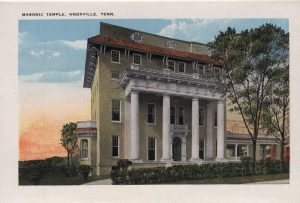
Charles McClung McGhee (1828-1907) was a Knoxville industrialist, banker, real estate developer, railroad magnate, and philanthropist. Born in Monroe County, Tennessee, his father was a wealthy farmer and his mother was the daughter of surveyor Charles McClung, who is best known for drawing up the original plat of Knoxville in 1791. His mother is also a granddaughter of Knoxville’s founder, James White. Throughout his childhood, McGhee lived in both Knoxville and Monroe County and graduated from East Tennessee University (now known as the University of Tennessee) in 1846. He permanently relocated to Knoxville in 1860 and became a wealthy businessman and industrialist. McGhee’s interests ran wide, and he became one of Knoxville’s most influential and successful citizens. McGhee is best known for helping establish the Lawson McGhee Library in 1885, which was dedicated to the memory of his daughter, May “Lawson” McGhee Williams, who had died in 1883 as a result of complications from the birth of her first child.
In March 1872, it was announced in the Knoxville Daily Chronicle that architectural plans had been designed for a new home to be built by McGhee on the site of his former residence on Locust Street. J.H. Gallaher was to be the architect, and it was to be designed in the Italian Villa style. By June 1872, the Knoxville Daily Chronicle had announced that Gallaher’s design had ultimately been rejected and McGhee had hired the young carpenter and architect, Joseph F. Baumann (1844-1920), to design and supervise the construction of a Second Empire style residence. The house was constructed of pressed brick and white mortar and featured an impressive mansard roof and wrap around verandas. The inside featured a parlor, library, billiard room, bathrooms, and well-ventilated bedrooms. The house sat on the crest of a hill a few blocks from Market Square, and the yard and gardens covered a full city block. When President Rutherford B. Hayes toured the Southern States in 1877, McGhee hosted a reception for 600 people in his honor! McGhee and his family lived in the house until his death in 1907. After the death of McGhee, the home was willed to his three adult daughters.
Masonic fraternities had been a staple in Knoxville throughout the 19th century but were officially incorporated as the Masonic Fraternity Association in 1908. After purchasing a four story commercial building at the northern corner of Market Square in 1910, the Association felt that the location did not fulfill its needs and sold the building in 1912. From the proceeds of the sale, the Association purchased the McGhee home in 1914 for its new headquarters. After hiring architect Albert B. Baumann, Sr. (1861-1942), the brother and former business partner of the original architect, Joseph Baumann, it was decided to drastically modify the exterior design and remodel the home into the new Masonic Temple. Construction of the Temple was done by Knoxville building contractor J.M. Dunn & Son and started in the fall of 1915. The Temple was completed in early 1916 and was officially dedicated on October 27, 1916.

While the outside looks very different, you can still see a few remnants of the original exterior design features. The two most prominent examples are the bay window on the south side of the house and the elaborate door surround at the main entrance. The interior has a number of original details still in place that include the main entry hall and staircase, interior woodwork, doors openings, and other interior details. While the Association included a number of original features into the remodel, they did modify a number of details. One of the main modifications was to add a third story to the building and combine rooms to accommodate the need for large gatherings. In order to accommodate the growing needs of the Association, an elevator was installed in 1968 and a kitchen and dining room was added in 1972.
Next time you’re downtown, take a stroll over to Locust Street and take a look at some Knoxville history! Make sure to notice the Y.M.C.A. that was built in 1929 and the 1916 Masonic Court (now known as Kendrick Place) named after the Masonic Temple!
Knox Heritage preserves structures and places of historic or cultural significance for our community. Founded in 1974, Knox Heritage is a nonprofit dedicated to historic preservation education, advocacy, and technical services. It also owns and operates Historic Westwood and the Airplane Filling Station. Knox Heritage is supported by members who value preserving historic places in our community. Learn more and become a member at www.knoxheritage.org.

